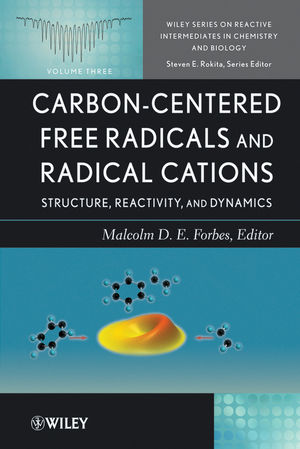Carbon-Centered Free Radicals and Radical Cations: Structure, Reactivity, and DynamicsISBN: 978-0-470-39009-2
Hardcover
392 pages
February 2010
 This is a Print-on-Demand title. It will be printed specifically to fill your order. Please allow an additional 10-15 days delivery time. The book is not returnable.
|
||||||
Preface to Series.
Introduction.
Contributors.
1. A Brief History of Carbon Radicals (Malcolm D. E. Forbes).
2. Intermolecular Radical Additions to Alkynes: Cascade-Type Radical Cyclizations (Uta Wille).
2.1 Introduction.
2.2 Cascade Reactions Involving Radicals of Second Row Elements.
2.3 Cascade Reactions Initiated by Addition of Higher Main Group (VI)-Centered Radicals to Alkynes.
2.4 Cascade Reactions Initiated by Addition of Higher Main Group (VI)-Centered Radicals to Alkynes.
2.5 Cascade Reactions Initiated by Addition of Higher Main Group (V)-Centered Radicals to Alkynes.
3. Radical Cation Fragmentation Reactions in Organic Synthesis (Alexander J. Poniatowski and Paul E. Floreancig).
3.1 Introduction.
3.2 Electron Transfer-Initiated Cyclization Reactions.
3.3 Oxidative Acyliminium Ion Formation.
3.4 Carbon–Carbon Bond Formation.
3.5 Summary and Outlook.
4. Selectivity in Radical Cation Cycloadditions (Christo S. Sevov and Olaf Wiest).
4.1 Introduction.
4.2 Mechanism and the Origin of the Rate Acceleration.
4.3 Selectivity in Radical Cation Cycloadditions.
4.4 Chemoselectivity.
4.5 Regioselectivity.
4.6 Periselectivity.
4.7 Endo/Exo Selectivity.
4.8 Conclusions.
5. The Stability of Carbon-Centered Radicals (Michelle L. Coote, Ching Yeh Lin, and Hendrik Zipse).
5.1 Introduction.
5.2 Theoretical Methods.
5.3 RSE Values for Carbon-Centered Radicals.
5.4 Use of RSE Values in Practical Applications.
5.5 Conclusions.
6. Interplay of Stereoelectronic Vibrational and Environmental Effects in Tuning Physicochemical Properties of Carbon-Centered Radicals (Vincenzo Barone, Malgorzata Biczysko, and Paola Cimino).
6.1 Introduction.
6.2 EPR Spectroscopy.
6.3 Calculation of EPR Parameters.
6.4 Vibrational Properties Beyond the Harmonic Approximation.
6.5 Electronic Properties: Vertical Excitation Energies, Structure, and Frequencies in Excited Electronic States.
6.6 Vibronic Spectra.
6.7 Concluding Remarks.
7. Unusual Structures of Radical Ions in Carbon Skeletons: Nonstandard Chemical Bonding by Restricting Geometries (Georg Gescheidt).
7.1 Introduction.
7.2 The Tools.
7.3 Pagodane and Its Derivatives.
7.4 Different Stages of Cycloaddition/Cycloreversion Reactions Within Confined Environments.
7.5 Extending the ‘‘Cage Concept’’.
7.6 Summary.
8. Magnetic Field Effects on Radical Pairs in Homogeneous Solution (Jonathan. R. Woodward).
8.1 Introduction.
8.2 The Spin-Correlated Radical Pair.
8.3 Application of a Magnetic Field.
8.4 Spin-State Mixing.
8.5 The Magnetic Field Dependence of Radical Pair
Reactions.
8.6 Theoretical Approaches.
8.7 Experimental Approaches.
8.8 The Life Cycle of Radical Pairs in Homogeneous Solution.
8.9 Summary.
9. Chemical Transformations Within the Paramagnetic World Investigated by Photo-CIDNP (Martin Goez).
9.1 Introduction.
9.2 CIDNP Theory.
9.3 Experimental Methods.
9.4 Radical—Radical Transformations During Diffusive Excursions.
9.5 Radical—Radical Transformations at Reencounters.
9.6 Interconversions of Biradicals.
9.7 Conclusions.
10. Spin Relaxation in Ru-Chromophore-Linked Azine/Diquat Radical Pairs (Matthew T. Rawls, Ilya Kuprov, C. Michael Elliott, and Ulrich E. Steiner).
10.1 Introduction.
10.2 EPR for the Isolated Ions.
10.3 Calculation Methods for EPR of the Isolated Ions.
10.4 Implications for Spin-Relaxation in Linked Radical Pairs.
11. Reaction Dynamics of Carbon-Centered Radicals in Extreme
Environments Studied by the Crossed Molecular Beam Technique
(Ralf I. Kaiser).
11.1 Introduction.
11.2 The Crossed Molecular Beam Method.
11.3 Experimental Setup.
11.4 Crossed Beam Studies.
11.5 Conclusions.
12. Laser Flash Photolysis of Photoinitiators: ESR, Optical, and IR Spectroscopy Detection of Transients (Igor V. Khudyakov and Nicholas J. Turro).
12.1 Introduction.
12.2 Photodissociation of Initiators.
12.3 TR ESR Detection of Transients.
12.4 Optical Detection of Transients.
12.5 IR Detection of Free Radicals and Monitoring Their Reactions.
12.6 Concluding Remarks.
13. Dynamics of Radical Pair Processes in Bulk Polymers (Carlos A. Chesta and Richard G. Weiss).
13.1 Introduction.
13.2 Singlet-State Radical Pairs from Irradiation of Aryl Esters and Alkyl Aryl Ethers.
13.2.1 General Mechanistic Considerations From Solution and Gas-Phase Studies.
13.3 Photo-Reactions of Aryl Esters in Polymer Matrices. Kinetic Information from Constant Intensity Irradiations.
13.4 Rate Information from Constant Intensity Irradiation of Alkyl Aryl Ethers.
13.5 Comparison of Calculated Rates to Other Methods for Polyethylene Films.
13.6 Triplet-State Radical Pairs.
13.7 Concluding Remarks.
14. Acrylic Polymer Radicals: Structural Characterization and Dynamics (Malcolm D. E. Forbes and Natalia V. Lebedeva).
14.1 Introduction.
14.2 The Photodegradation Mechanism.
14.3 Polymer Structures.
14.4 The Time-Resolved EPR Experiment.
14.5 Tacticity and Temperature Dependence of Acrylate Radicals.
14.6 Structural Dependence.
14.7 Oxo-Acyl Radicals.
14.8 Spin Polarization Mechanisms.
14.9 Solvent Effects.
14.10 Dynamic Effects.
14.11 Conclusions.
Index.



